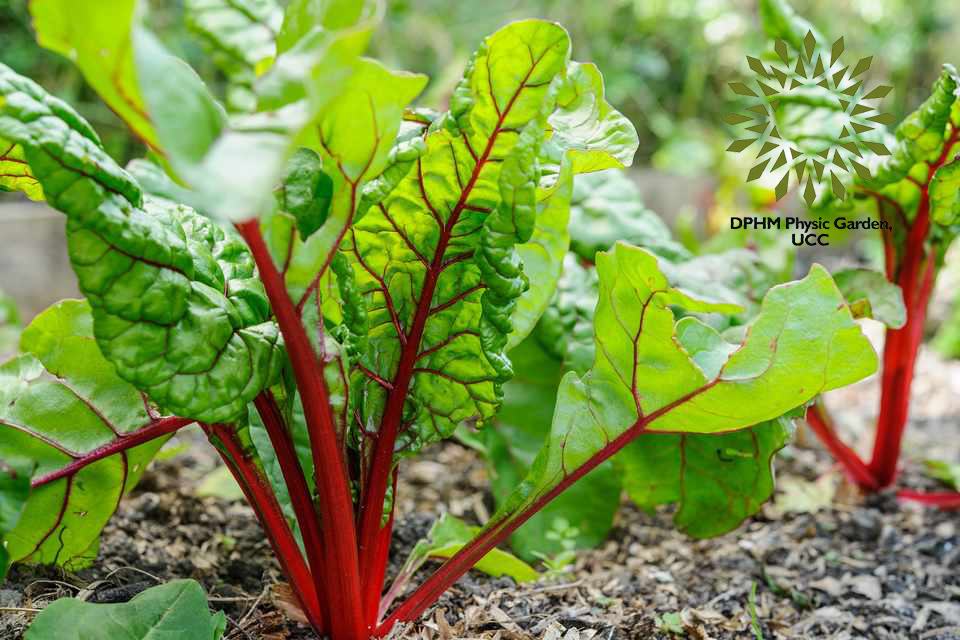BETA VULGARIS
BOTANICAL DESCRIPTION
Lower leaves are oblong, obtuse, trowel shaped and up to 25 cm long. Upper leaves are lanceolate, Rhombicovate and heart shaped. Flowers are very small with a diameter of 3-5mm, Greenish or tinged reddish with five petals and bisexual Spikes Slender, 15 -45 cm long. Their seeds are orizontal with a skinny seed coat, floury albumen and annular embryo. Stem produces simple leaves which can be arranged in a closed spiral. It is short and plate. Roots are true Biennial, stout, swollen forming a beet together with the hypocotyl, and a branched taproot.
TAXONOMY
Family: Amaranthaceae
Genus: Beta
Species: Vulgaris
Botanical Name: Beta vulgaris
COMMON NAMES
Beet, Beetroot, Garden Beet, Table Beet, Red Beet, Dinner Beet, Golden Beet and
Sea Beet.
LOCAL NAMES
Akan: "Nkuto" or "Bitter Beet"
Ga-Adangbe: "Dammabo"
Ewe: "Beti"
SYNONYMS
Beta alba DC, Beta carnulosa Gren, Beta crispa Tratt, Beta altissima Steud., Beta esculenta Salisb., Beta hybrid Andrz.
PHYTOCHEMICAL SCREENING
Phytochemical screening revealed the presence of betalains comprising betacyanins and betaxanthins, phenolic compounds, such as catechin hydrate, epicatechin, ferulic acid, protocatechuic acid, vanillic acid, p-coumaric acid, p-hydroxybenzoic acid, and caffeic acid. Notable flavonoids present in beetroot include astragalin, tiliroside, rhamnocitrin, kaempferol, and rhamnetin and it also contains vitamins (B complex and C), minerals, fibre, proteins, carotenoids, sesquiterpenoids, triterpenes, glycine betaines, saponins, and folates.
CHEMICAL STRUCTURE
PHARMACOLOGICAL ACTIVITY
ANTI-ANAEMIC ACTIVITY
Beetroot ethanolic extracts, rich in essential nutrients like ascorbic acid, folic acid, and iron, have been found to have anti-anemic properties. When administered to anemic rats, the ethanolic extract increased the number of erythrocytes and hemoglobin concentration, suggesting that beetroot extract has anti-anemic properties due to its high content of these nutrients(Jaiswal et al., 2014).
ANTI-CANCER ACTIVITY
Research has shown that the extract of Beta vulgaris, when used in conjunction with silver nanoparticles, displayed anticancer properties against several human cancer cell lines, including those associated with breast and lung cancers. This study highlights the promising role of beetroot extracts in cancer treatment.
ANTIOXIDANT ACTIVITY
The antioxidant properties of Beta vulgaris are primarily due to its rich content of bioactive compounds, including betalains, flavonoids, and polyphenols. These compounds effectively scavenge reactive oxygen species (ROS), reducing oxidative stress in the body. Additionally, beetroot enhances the activity of antioxidant enzymes, which further helps neutralize free radicals.
ANTI-INFLAMMATORY ACTIVITY
Beetroot's anti-inflammatory properties are attributed to its betalain content, which modulates inflammatory responses. It inhibits pro-inflammatory cytokines like TNF-α and IL-1β, reduces leukocyte recruitment, and decreases superoxide anions, thereby reducing inflammation and tissue damage.
ANTIMICROBIAL ACTIVITY
Beetroot betalains, pigments, have shown antimicrobial properties against various microbes, including drug-resistant bacteria. They combat single-species and multi-species biofilms, and have antiviral activity against viruses like dengue and SARS-CoV-2, indicating potential therapeutic applications in treating infections.
CARDIOVASCULAR HEALTH
Beta vulgaris has significant cardiovascular benefits due to its high nitrate content, which converts into nitric oxide, promoting vascular function and reducing systolic blood pressure. Its bioactive substances, including polyphenols and betalains, also reduce oxidative stress and inflammation.
ANTIHYPERCHOLESTEROLEMIC
A study found that Beta vulgaris extract protects rats from hypercholesterolemia caused by a 1% cholesterol-rich diet. Over 70 days, BVE at doses of 250 and 500 mg/kg reduced total cholesterol and triglycerides, while increasing HDL-C levels.
ANTIDEPRESSANT
Beetroot's antidepressant properties are attributed to its ability to modulate neurotransmitter systems, specifically serotonin and dopamine. Studies show it increases serotonin receptor expression and dopamine receptor expression in animal models. Beetroot's high folate content and antioxidant compounds may help manage depression and anxiety due to their potential to reduce oxidative stress and inflammation in the brain.
HEPATOPROTECTIVE ACTIVITY
Research has indicated that beetroot extract may facilitate the regeneration of liver cells, especially pancreatic beta cells, thereby aiding in the restoration of normal liver function. This effect is probably driven by bioactive compounds such as betaine, which can influence cellular processes related to tissue repair and regeneration.
ETHNOMEDICINAL USES
Beta vulgaris, is a traditional medicine used to treat health issues like constipation, liver problems, joint pain, and mental health. Its healing properties, including reducing inflammation and protecting the liver, have been supported by recent studies, highlighting its importance in both traditional and modern medicine.
TOXICOLOGICAL PROFILE
Recent studies on Beta vulgaris extracts have shown moderate toxicity, with an estimated LD50 of 305 mg/kg. Although not fatal at doses above 5,000 mg/kg, the extract's betacyanin component falls into toxicity class IV.
DRUG-DRUG INTERACTION
Recent studies show betanin inhibits CYP3A4, a crucial enzyme in medication metabolism, in a dose-dependent manner, potentially altering pharmacokinetics. Therefore, caution should be exercised when using betanin-containing products with drugs requiring CYP3A4 metabolism. Nitrate-Rich Beetroot Juice and PDE-5 Inhibitors: Beetroot's high nitrate content can cause vasodilation, and when combined with PDE-5 inhibitors like sildenafil, it can lead to significant blood pressure drops, requiring careful monitoring. General Drug Interactions: Beetroot may affect medication metabolism by altering nitric oxide pathways and interacting with metabolic enzymes, so individuals on multiple medications should consult healthcare professionals for potential herb-drug interactions.
CLINICALLY VALIDATED USES
Beetroot juice improves cardiovascular health by lowering blood pressure, improving endothelial function, and reducing arterial stiffness. It may also manage diabetes, improve insulin sensitivity, and protect against lead-induced neurotoxicity.
REFERENCES
Al-Dosari, M., Alqasoumi, S., Al-Yahya, M., & Ansari, M. N. (2011). EFFECT OF BETA VULGARIS L. ON CHOLESTEROL RICH DIET-INDUCED HYPERCHOLESTEROLEMIA IN RATS. 59.
Babarykin, D., Smirnova, G., Pundinsh, I., Vasiljeva, S., Krumina, G., & Agejchenko, V. (2019). Red Beet (<i>Beta vulgaris</i>) Impact on Human Health. Journal of Biosciences and Medicines, 07(03), 61–79. https://doi.org/10.4236/jbm.2019.73007
Benjamim, C. J. R., S. Júnior, F. W., De Figueirêdo, M. Í. L. S., Benjamim, C. J. R., Cavalcante, T. C. F., Da Silva, A. A. M., Monteiro, L. R. L., Santana, M. D. R., Garner, D. M., & Valenti, V. E. (2021). Beetroot ( Beta Vulgaris L. ) Extract Acutely Improves Heart Rate Variability Recovery Following Strength Exercise: A Randomized, Double-Blind, Placebo-Controlled Crossover Trial-Pilot Study. Journal of the American College of Nutrition, 40(4), 307–316. https://doi.org/10.1080/07315724.2020.1774441
Edziri, H., Jaziri, R., Haddad, O., Anthonissen, R., Aouni, M., Mastouri, M., & Verschaeve, L. (2019). Phytochemical analysis, antioxidant, anticoagulant and in vitro toxicity and genotoxicity testing of methanolic and juice extracts of Beta vulgaris L. South African Journal of Botany, 126, 170–175. https://doi.org/10.1016/j.sajb.2019.01.017
Ghanbari, P., Khajehzadeh, S., Sayyed, A., Raeisi, D., & Salehi, O. (2022). The effect of high intensity interval training with beetroot (Beta vulgaris) juice supplementation on serotonin and dopamine receptors expression, anxiety and depression in middle-aged diabetic rats. Avicenna Journal of Phytomedicine, 12(6). https://doi.org/10.22038/ajp.2022.20895
Hamedi, S., & Honarvar, M. (2019). Beta vulgaris – A Mini Review of Traditional Uses in Iran, Phytochemistry and Pharmacology. Current Drug Discovery Technologies, 16(1), 74–81. https://doi.org/10.2174/1570163815666180308142912
Jaiswal, A., Ganeshpurkar, A., Awasthi, A., Bansal, D., & Dubey, N. (2014). Protective Effects of Beetroot Extract against Phenyl Hydrazine Induced Anemia in Rats. Pharmacognosy Journal, 6(5), 1–4. https://doi.org/10.5530/pj.2014.5.1
Kikuzaki, H., Hisamoto, M., Hirose, K., Akiyama, K., & Taniguchi, H. (2002). Antioxidant Properties of Ferulic Acid and Its Related Compounds. Journal of Agricultural and Food Chemistry, 50(7), 2161–2168. https://doi.org/10.1021/jf011348w
Lange, W., Brandenburg, W. A., & Bock, T. S. M. D. (1999). Taxonomy and cultonomy of beet (Beta vulgaris L.). Botanical Journal of the Linnean Society, 130(1), 81–96. https://doi.org/10.1111/j.1095-8339.1999.tb00785.x
Lim, S. H., Bae, S., Lee, H. S., Han, H.-K., & Choi, C.-I. (2023). Effect of Betanin, the Major Pigment of Red Beetroot (Beta vulgaris L.), on the Activity of Recombinant Human Cytochrome P450 Enzymes. Pharmaceuticals, 16(9), 1224. https://doi.org/10.3390/ph16091224
Martinez, R. M., Longhi-Balbinot, D. T., Zarpelon, A. C., Staurengo-Ferrari, L., Baracat, M. M., Georgetti, S. R., Sassonia, R. C., Verri, W. A., & Casagrande, R. (2015). Anti-inflammatory activity of betalain-rich dye of Beta vulgaris: Effect on edema, leukocyte recruitment, superoxide anion and cytokine production. Archives of Pharmacal Research, 38(4), 494–504. https://doi.org/10.1007/s12272-014-0473-7
Mirmiran, P., Houshialsadat, Z., Gaeini, Z., Bahadoran, Z., & Azizi, F. (2020). Functional properties of beetroot (Beta vulgaris) in management of cardio-metabolic diseases. Nutrition & Metabolism, 17(1), 3. https://doi.org/10.1186/s12986-019-0421-0
Nugraha, S. E., Keliat, J. M., Marianne, & Syahputra, R. A. (2024). INVESTIGATING THE TOXICITY OF BETALAIN COMPOUNDS: IN SILICO ANALYSIS AND IN VIVO PREDICTIONS FOR STANDARDIZED BETA VULGARIS L. EXTRACT. International Journal of Applied Pharmaceutics, 118–123. https://doi.org/10.22159/ijap.2024v16i1.49189
Punia Bangar, S., Sharma, N., Sanwal, N., Lorenzo, J. M., & Sahu, J. K. (2022). Bioactive potential of beetroot (Beta vulgaris). Food Research International, 158, 111556. https://doi.org/10.1016/j.foodres.2022.111556
Shaban, N. Z., Abd El-Kader, S. E., Mogahed, F. A. K., El-Kersh, M. A. L., & Habashy, N. H. (2021). Synergistic protective effect of Beta vulgaris with meso-2,3-dimercaptosuccinic acid against lead-induced neurotoxicity in male rats. Scientific Reports, 11(1), 252. https://doi.org/10.1038/s41598-020-80669-4
Singh, R., & Singh, G. (2022). A REVIEW ON BETA VULGARIS.
Tan, M. L., & Hamid, S. B. S. (2021). Beetroot as a Potential Functional Food for Cancer Chemoprevention, a Narrative Review. Journal of Cancer Prevention, 26(1), 1–17. https://doi.org/10.15430/JCP.2021.26.1.1
Tumbas Šaponjac, V., Čanadanović-Brunet, J., Ćetković, G., Jakišić, M., Djilas, S., Vulić, J., & Stajčić, S. (2016). Encapsulation of Beetroot Pomace Extract: RSM Optimization, Storage and Gastrointestinal Stability. Molecules, 21(5), 584. https://doi.org/10.3390/molecules21050584
Venugopal, K., Ahmad, H., Manikandan, E., Thanigai Arul, K., Kavitha, K., Moodley, M. K., Rajagopal, K., Balabhaskar, R., & Bhaskar, M. (2017). The impact of anticancer activity upon Beta vulgaris extract mediated biosynthesized silver nanoparticles (ag-NPs) against human breast (MCF-7), lung (A549) and pharynx (Hep-2) cancer cell lines. Journal of Photochemistry and Photobiology B: Biology, 173, 99–107. https://doi.org/10.1016/j.jphotobiol.2017.05.031
Wijesinghe, V. N., & Choo, W. S. (2022). Antimicrobial betalains. Journal of Applied Microbiology, 133(6), 3347–3367. https://doi.org/10.1111/jam.15798

INFORMATION, DATA AND PICTURES ARE COPYRIGHT OF DPHM, SCHOOL OF PHARMACY, UCC.

